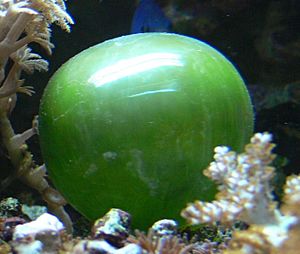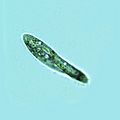Unicellular organism facts for kids

Unicellular organisms are living things that have only one cell. They are super tiny, and you usually need a microscope to see them! Even though they are all single-celled, they come in two main types, which are very different from each other.
- Prokaryotes are simple cells like bacteria and archaea. Their cells do not have a special control center called a nucleus.
- Eukaryotes are more complex cells. They have a nucleus and other tiny parts inside called organelles.
The biggest difference between prokaryotes and eukaryotes is that eukaryotes have a nucleus and other special parts, while prokaryotes do not.
Contents
Seeing Unicellular Organisms
Most unicellular organisms are microorganisms, meaning they are too small to see with just your eyes. But you can easily observe many eukaryotes and even some prokaryotes using a compound microscope. Bacteria often look like tiny dark dots.
Want to find them? You can place a glass cover slip on top of pond water and leave it overnight. By morning, lots of unicellular organisms will have grown on the bottom of the slip! They multiply super fast, sometimes doubling their numbers in just 30 minutes to a few hours.
Where They Live and How They Survive
Unicellular organisms are found almost everywhere on Earth! They were some of the very first forms of life, appearing about 3.8 billion years ago, or even earlier.
They have many clever ways to survive:
- Photosynthesis: Some, like cyanobacteria, make their own food using sunlight, just like plants.
- Chemotrophy: Others, like many archaea, get energy from chemical reactions.
- Heterotrophy: Some, like amoeba, eat other organisms or bits of food.
How They Move
Some unicellular organisms have special ways to move around:
- Flagella: These are like little tails that they use to swim.
- Lobopods: These are blob-like "arms" that extend from their cell, helping them crawl or grab things.
It's cool to think that the flagella found in our ancient single-celled ancestors can still be seen today, for example, as the tails on sperm cells in animals!
Size of Unicellular Organisms
Unicellular organisms come in a huge range of sizes. The smallest bacteria are only about 300 nanometers across (that's super tiny!). On the other hand, some amazing single-celled slime molds can grow up to 20 cm (8 in) wide!
To see the smallest ones, you need a powerful electron microscope. But the very largest unicellular organisms can sometimes be seen with a regular microscope or even just a magnifying glass. Some of the biggest ones can even have millions of nuclei scattered throughout their single cell!
Related pages
Images for kids
-
Modern stromatolites in Shark Bay, Western Australia. It can take a century for a stromatolite to grow 5 cm.
-
A scanning electron microscope image of a diatom.
See also
 In Spanish: Organismo unicelular para niños
In Spanish: Organismo unicelular para niños






